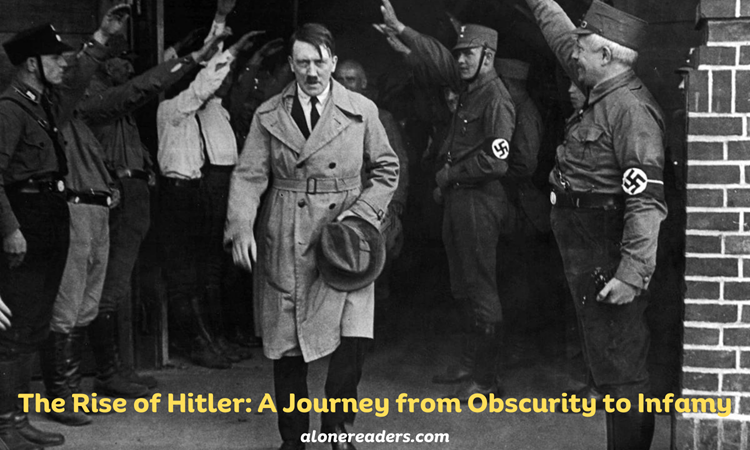
The history of the 20th century is indelibly marked by the figure of Adolf Hitler, a man whose rise from a relatively obscure background to the heights of dictatorial power remains one of the most infamous trajectories in modern history. His story is not only a reflection of his personal ambitions and ideologies but also of the particular circumstances of the time which allowed such a character to seize control of a nation. This article aims to unravel the complex series of events and the environment that facilitated Hitler’s metamorphosis into the Führer of Nazi Germany.
Adolf Hitler was born on April 20, 1889, in Braunau am Inn, a small town in Austria-Hungary. His early life was not particularly remarkable; he was a mediocre student who showed an early interest in German nationalism and a passion for art. After being rejected twice by the Academy of Fine Arts Vienna, he lived a bohemian life, painting postcards and advertisements for a living.
The turning point in Hitler's early life came with World War I. He served with distinction in the Bavarian Army, receiving the Iron Cross for bravery, but was never promoted beyond private first class. The war gave Hitler a sense of purpose, and the German defeat left him deeply embittered. He, like many Germans, found it hard to accept the humiliating terms of the Treaty of Versailles, which ended the war, and he subscribed to the "stab-in-the-back" myth, blaming the defeat on internal enemies like Marxists and Jews, rather than on military failure.
The post-war period saw Germany in turmoil. The Weimar Republic, established after the war, was struggling with economic instability, political extremism, and a disillusioned populace. It was in this context that Hitler discovered the German Workers’ Party (DAP), which he joined in 1919. His oratorical skills and fervent nationalist messages quickly elevated him within the party ranks, and by 1921, he had assumed leadership, renaming it the National Socialist German Workers’ Party (NSDAP) or Nazi Party.
The early 1920s were marked by Hitler’s attempts to push his agenda through propaganda and grow the party’s membership. He capitalized on public discontent, especially focusing on anti-Semitic, anti-Marxist, and anti-capitalist propaganda, which resonated with a population struggling with hyperinflation and a fear of Communist revolution.
Hitler's first significant attempt to grasp power was the Beer Hall Putsch of 1923, an attempted coup d'état in Munich. The failure of this putsch landed Hitler in prison, where he wrote "Mein Kampf" (“My Struggle”), outlining his ideology and future plans for Germany. Although the putsch was a failure, it turned Hitler into a national figure, and "Mein Kampf" became the foundational text for the Nazi movement.
Upon his release from prison, Hitler pursued a path to power through legal means. The Nazi Party employed a potent combination of violent intimidation tactics via the SA ("Brownshirts") and shrewd political strategy. The party's message was fine-tuned to exploit the fears and grievances of various segments of the German population, with promises to restore German greatness, rebuild the economy, and solve the so-called "Jewish question."
The global economic turmoil of the Great Depression was the final element necessary for Hitler’s ascendancy. The Nazi party's anti-establishment rhetoric struck a chord with voters, and by 1932 the Nazis were the largest party in the German Reichstag. However, it wasn’t until January 30, 1933, that Hitler was appointed Chancellor of Germany, following backroom political deals made by conservative elites who thought they could control him.
Once in power, Hitler moved quickly to consolidate his control. The Reichstag Fire of February 1933 provided a pretext to declare a state of emergency, enabling him to arrest communists and suspend civil liberties. With the passing of the Enabling Act, Hitler had effectively dismantled the Weimar Republic and could legislate by decree.
The following years saw the "Gleichschaltung," where all aspects of German life were brought under Nazi control. Political opponents were eliminated, independent organizations were dissolved, and the state apparatus was used to propagate Nazi ideology. Hitler's control was bolstered by an economic revival fueled by massive public works programs and rearmament, reinforcing his image as Germany’s savior.
The rise of Hitler was not an aberration but the culmination of a confluence of deep social unrest, political ineptitude, and economic crisis. Hitler's ability to tap into the German psyche, exacerbated by a perfect storm of post-war resentment, political instability, and economic desperation, set the stage for his rise to power. His manipulation of the democratic process and the exploitation of emergency powers to establish a totalitarian regime are chilling reminders of the fragility of democratic systems.
Understanding how "Hitler became Hitler" is crucial. It reminds us of the dangers of charismatic demagoguery, the exploitation of societal fears, and the vulnerabilities of democratic institutions in times of crisis. It is a cautionary tale of what can happen when the darker forces of nationalism and xenophobia are harnessed by a ruthless individual who emerges, not in spite of a society’s turmoil, but because of it.